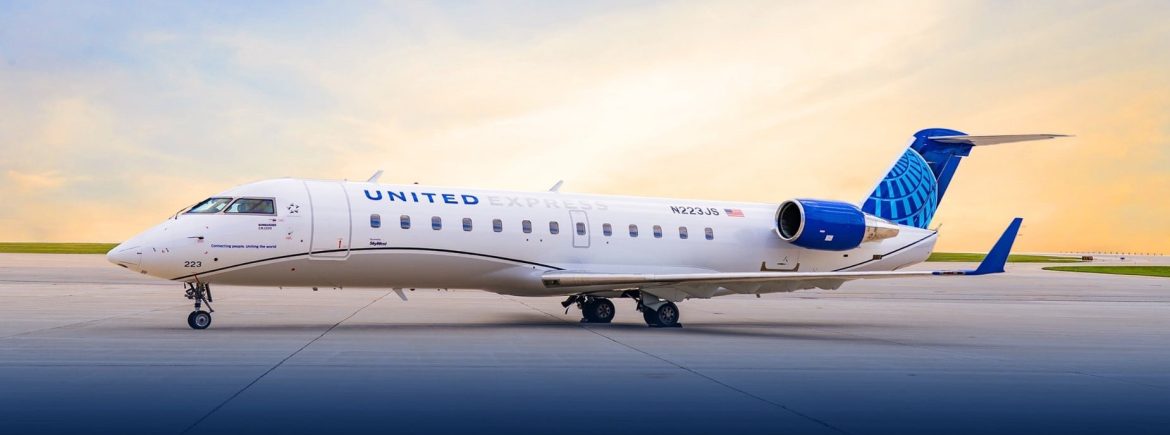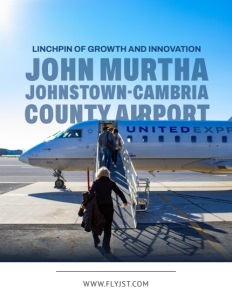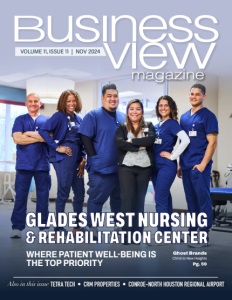John Murtha Johnstown-Cambria County Airport
Linchpin of Growth and Innovation
This dynamic aviation hub is supporting the future of regional air travel and economic development in Cambria County.
The John Murtha Johnstown-Cambria County Airport (JST) may be tucked away in Cambria County, Pennsylvania but it offers an impressive array of services and facilities for commercial and general aviation. SkyWest Airlines, operating under the United Express brand, provides daily round-trip flights to Washington Dulles and Chicago O’Hare using 50-seat jets—a critical link for local travelers to major hubs. Airport Manager Cory Cree explains, “We’re connected to two major cities seven days a week, which is invaluable for residents and business travelers in the region.”
Beyond passenger flights, the airport supports a thriving general aviation community, with private aircraft housed in T-hangars and unit hangars. Cree highlights the role of Nulton Aviation Services, the airport’s fixed-base operator, which offers a comprehensive suite of services from aircraft maintenance and refueling to storage. This FBO also hosts the Nulton Aviation Flight Academy in partnership with Saint Francis University.
The airport’s facilities are expanding in new ways as well. Saint Francis University opened an Aircraft Maintenance Technician School in the airport’s Hangar 15 complex this fall. The program is a major addition, with classes kicking off in late August and a ribbon-cutting ceremony held shortly after. “This school brings new educational opportunities to the area and opens doors to aviation careers,” Cree says, mentioning that graduates will be positioned to secure interviews with SkyWest Airlines. As part of the airport’s growth, a new $5.6 million Eastside Development Project will enhance the infrastructure, including a widened access road, a 162-space parking lot, and a reconstructed apron to support the maintenance school.
In another significant development, Johnstown’s popular Balance Restaurant will open a second location at the airport in January 2025. Cree notes, “This is something we’re really excited about—having a well-known restaurant at the airport will be a great amenity for travelers and locals.” At the same time, the airport also boasts robust air traffic control support, operated by the Pennsylvania Air National Guard’s 258 Air Traffic Control Squadron. Its 7,004-foot concrete runway, capable of handling military aircraft, often hosts Black Hawk helicopters and occasionally sees high-profile landings.
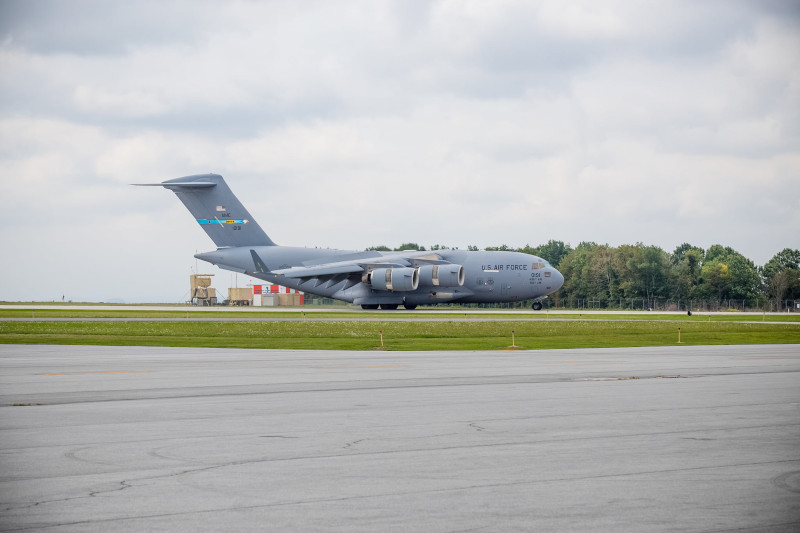
Building an Aviation Training Hub
JST is undergoing a substantial transformation, focused on developing its Hangar 15 complex into a fully functional aviation education hub. Over the past few years, more than $2 million has been invested to repurpose this space. The complex, which includes two hangars with an office building in between, now hosts classrooms, a bookstore, and lounge areas to accommodate students in Saint Francis University’s Aircraft Maintenance Technician program. “We’ve created a campus-like atmosphere,” Cree says, describing how aviation maintenance and flight training students are now integrated into this revitalized space.
The renovations don’t stop at interiors; a new 162-space parking lot is being added to support the technician program and the Nulton Aviation Flight Academy, which also operates out of the complex. “We wanted a designated parking area for students that didn’t compromise airfield security,” explains Cree. The new layout will place the parking lot outside the airport’s secure perimeter, ensuring easy classroom access without passing through restricted areas. Adjacent to Hangar 15, the airport is investing in a complete overhaul of the apron, which Cree describes as “in bad shape.” “Saint Francis University has acquired several aircraft for hands-on training,” he adds. The upgraded apron will be essential as students gain practical skills in engine maintenance and other core aviation tasks directly on-site.
Also, in collaboration with Pennsylvania’s Keystone Opportunity Expansion Zone (KOEZ), the airport has designated 129 acres for tax-relief incentives to attract new businesses. “We’re widening the access road to support two-lane, tractor-trailer traffic, which will enable us to further develop that area,” says Cree. This improvement, combined with the KOEZ tax breaks, will draw companies that might benefit from proximity to the airport’s aviation resources and skilled labor pipeline. The airport also has plans to construct a regional jet (RJ) hangar and an innovation center within the KOEZ area. “This would give us a facility for aircraft storage and maintenance,” says Cree, noting that the innovation center could serve as a base for technology development in fields like drone research.
Partnering for Growth and Tourism
As JST looks to attract new business, airport manager Cree emphasizes the critical role of political and economic partnerships. Securing funding for the planned RJ hangar and innovation center has involved support from federal representatives like Dr. John Joyce and GT Thompson. “Dr. Joyce has helped us secure initial funding for the innovation center, and Rep. Thompson assisted with the Eastside development project,” he explains. While the full $30 million isn’t yet in hand, these efforts are building momentum to complete the project’s first phase and create an anchor for future commercial growth.
The airport authority is also proactively seeking tenants, working with the Cambrian Hills Development Group to market the site to potential businesses. “They’re targeting companies in aviation maintenance, repair, and overhaul (MRO) as well as Department of Defense contractors,” says Cree. The airport is well-situated for these industries, given its proximity to a principal DoD contractor in a nearby industrial park. Recently, the development group attended an MRO conference in Chicago, aiming to attract top players in aviation services. While no agreements have been signed yet, Cree remains optimistic about finding a committed tenant.
Tourism is another focal point for the airport’s growth strategy. Cree describes a collaborative approach to promote local attractions to incoming travelers, especially those arriving on general aviation (GA) flights. “We’re working closely with visitors’ bureaus in both Cambria and Indiana counties,” he notes. Sports tourism is also featured in the airport’s outreach efforts. “We try to promote the Johnstown Tomahawks,” says Cree, pointing out the team’s ties to the Midwest, where hockey culture runs deep. “Many Tomahawks players and part of the ownership hail from Chicago, giving the airport an angle to market Johnstown as a destination to hockey fans and families traveling from the Midwest,” he adds.
Economic and Educational Growth
JST is pivotal in the local economy, driven by its commercial jet service and strategic community partnerships. “The jet service from SkyWest and United Express has been essential,” says Cree. Many companies require employees to fly on multi-engine aircraft for business trips, making the jet service a vital link for corporate travelers. “It’s brought business travelers back to the airport,” he adds, signifying how critical these flights are for local economic activity. The airport’s economic impact extends through its state-backed Airport Land Development Zone, which offers tax credits to attract new businesses and employment.
The airport’s ambitions aren’t limited to traditional aviation; it’s also pushing forward in the rapidly evolving drone industry. Cree highlights the role of a nonprofit called Aerium, which promotes aviation education and technological advancement. “Aerium has been instrumental in introducing aviation courses at the high school level and collaborating with universities,” Cree explains. “In partnership with the Southern Alleghenies Planning Commission, Aerium secured a $1.9 million Smart grant to install sensors across Cambria County,” he adds. This project, Cree says, will enable drones to fly beyond visual line of sight for emergency response, potentially delivering life-saving equipment like Narcan or defibrillators faster than ground transport in rural areas.
In addition to tech advancements, the airport has become a hub for aviation education through Aerium’s annual summit. Hosted at the airport, the Aerium Summit gathers educators, industry professionals, and students to explore aviation careers. “We bring in high school teachers, guidance counselors, and even students to connect with pilots, engineers, and military representatives,” Cree explains. “The event provides hands-on insights into diverse aviation paths—from mechanics to roles with the Department of Defense,” he adds.
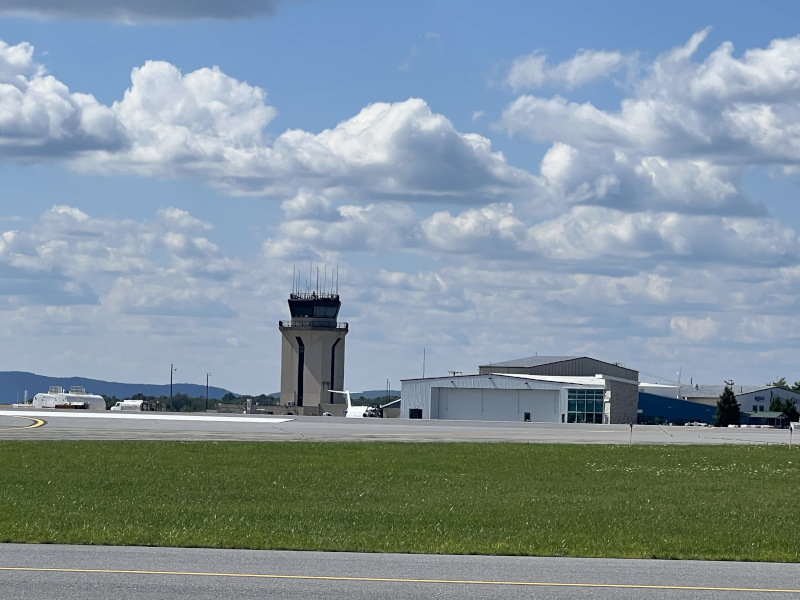
Inspiring the Next Generation of Aviators
JST has made education and outreach central to its mission, actively working to cultivate a passion for aviation among young people. “We’ve given tours of our military reserve unit and the nearby DoD contractors and even offered discovery flights for students interested in learning to fly,” Cree says. These flights and access to flight simulators allow students to experience aviation first-hand. In an industry facing shortages of pilots and mechanics, he sees these initiatives as critical steps toward engaging a younger generation in aviation careers.
The airport promotes aviation education at multiple levels through partnerships with Aerium and other local organizations. Aerium’s work includes establishing high school aviation courses and collaborating with colleges to build more advanced programs. “Aerium’s focus on aviation education is something we’re proud to support,” Cree notes, adding that the airport is committed to backing any initiative that advances aviation in the state. From drone flight testing with the Southern Alleghenies Planning Commission to training pilots and mechanics with Saint Francis University and Nulton Aviation, the airport is open to all partnerships that drive growth in aviation.
The airport’s outreach extends beyond formal education. As a board member of the Aviation Council of Pennsylvania, Cree collaborates with other airport managers and state aviation leaders to share resources and strategies. “All of us in the council want to work together to promote aviation,” he says. “This collaborative network supports Aerium’s efforts and helps align aviation goals across the state, creating a more cohesive approach to addressing workforce challenges and fostering new talent.”
Expanding Services and Infrastructure
Looking ahead, JST is focused on securing its position as a valuable transit hub while enhancing services and infrastructure. Maintaining its critical jet service through SkyWest Airlines under the Essential Air Service (EAS) program is a top priority. “We’re committed to keeping our daily connections to Washington, D.C. and Chicago,” Cree says, noting that the airport will rebid its service contract with the Department of Transportation in late 2025. Additionally, the airport is exploring partnerships with ultra-low-cost carriers to introduce nonstop flights to popular destinations like Orlando and Fort Lauderdale, addressing strong local demand for direct routes to Florida.
Cree is also eager to support the new Balance Restaurant, set to open in January 2025, to ensure it thrives as a welcoming option for passengers and the public. “We’re partnering with them to spread the word about the restaurant’s launch,” he says. Meanwhile, on the infrastructure front, Cree has ambitious plans to expand general aviation facilities. By spring 2025, the airport will bid on a site preparation project for eight new box hangars to accommodate 42-by-45-foot aircraft. “We’ll be seeking grant funding to fully construct these hangars in 2026,” he notes, adding that this addition will attract more private pilots and aviation enthusiasts, adding a new revenue stream and strengthening the airport’s general aviation offerings.
Routine upgrades to the airfield itself are also a priority. In 2026, the airport will replace taxiway lights and signs with energy-efficient LED systems, an investment Cree says will reduce electrical costs. “In 2025, we’re also planning to rehabilitate our main terminal apron where our commuter airline parks,” he adds, ensuring the airport’s core infrastructure remains functional and up-to-date. These improvements and strategic expansions signal a forward-looking approach as the airport strives to meet the growing community and traveler needs.
AT A GLANCE
John Murtha Johnstown-Cambria County Airport
What: Regional airport with commercial, general aviation, and aviation education facilities
Where: Cambria County, Pennsylvania
Website: https://flyjst.com/
PREFERRED VENDORS
Saint Francis University – Aviation Education Center – francis.edu/aviation
Saint Francis University expands career opportunities in the aviation industry and beyond
Saint Francis University is tackling workforce shortages in the aviation industry by expanding its career-focused programs, emphasizing its new Aviation Maintenance Technician (AMT) program. Located at the Aviation Education Center at the Johnstown Airport, the AMT program is designed to meet the critical need for skilled aviation maintenance professionals. This FAA-certified, hands-on program can be completed in 21 months, preparing students for certification and a wide range of career opportunities in aviation. Students in the AMT program also have access to SFU’s Elite Partnership with SkyWest Airlines through the AMT Pathway Program, offering job placement assistance and tuition reimbursement of up to $17,500 upon reaching key milestones.
While the AMT program is at the forefront, SFU continues to offer a robust Aviation Specialization (Pilot License Training) in partnership with Nulton Aviation Services. This 21-credit specialization allows students to work toward a Private and Commercial Pilot License, enhancing their marketability in various fields. The SkyWest Pilot Pathway Program further supports aspiring pilots with financial incentives.
By offering both pilot training and aviation maintenance programs, SFU ensures that students have access to in-demand career paths in the aviation sector. Visit francis.edu/aviation for more details.
